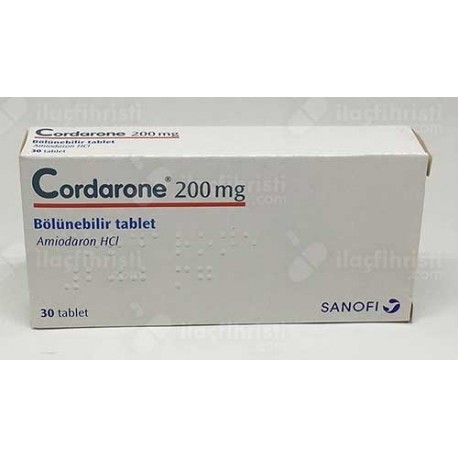Cordarone (amiodarone) Vial and Tablets
New product
BUY MORE PAY LESS
| Quantity | Discount | |
|---|---|---|
| 2 | 5% | |
| 3 | 10% | |
| 4 | 15% | |
| 5 | 20% |
Volume discounts
| Quantity | Discount | You Save |
|---|---|---|
| 2 | 5% | Up to $2.90 |
| 3 | 10% | Up to $8.70 |
| 4 | 15% | Up to $17.40 |
| 5 | 20% | Up to $29.00 |
More info
CLINICAL FEATURES
4.1. Therapeutic indications
CORDARONE should be used in the treatment of the following severe rhythm disturbances when oral administration is not possible.
Atrial arrhythmia with rapid ventricular rhythm.
- Tachycardia due to Wolf-Parkinson White syndrome.
- Diagnosed, symptomatic ventricular arrhythmia.
4.2. Posology and method of administration
Posology / application deletion and duration:
Intravenous infusion:
Loading therapy:
The average dose is 5 mg / kg in 250 ml of 5% dextrose solution. This dose is administered over a period of 20 minutes to 2 hours, preferably using the electric syringe (infusion pump), and repeated 2 or 3 times in 24 hours.
The short duration of the effect of the medicinal product requires continued infusion.
Maintenance therapy:
It is administered as 10-20 mg / kg / day (average 600-800 mg in 24 hours, maximum 1200 mg in 24 hours) in 250 ml of 5% dextrose solution for several days.
Transition to oral therapy:
Oral treatment is started from the first day of infusion (200mg tablets 3 times a day). This dose can be increased to 4 or even 5 tablets per day. Subsequently, intravenous administration should be stopped gradually.
Intravenous injection:
The dose is 5mg / kg administered in at least 3 minutes. It should not be mixed with any medication in the same syringe.
Only limited to cardio-pulmonary resuscitation of shock-resistant ventricular fibrillation, 300 mg (or 5 mg / kg) of amiodarone as an initial dose can be diluted in 20 ml of 5% dextrose solution and administered by IV bolus injection. If ventricular fibrillation continues, an additional IV dose of 150 mg (or 2.5 mg / kg) may be considered.
Method of Application:
Due to the formulation of the product, the drug should not be used at a concentration less than 2 ampoules in 500 ml. Only isotonic glucose (dextrose) solution should be used. No other product should be added to the infusion solution.
Amiodarone should be administered through a central venous route.
Misunderstanding:
The use of PVC materials or medical devices plasticized with DEHP di (2-ethylhexyl) phthalate may result in the release of DEHP in the presence of amiodarone injection solution. To minimize the patient's exposure to DEHP, before infusion, the final dilution of amiodarone, DEHP-free hardware, -DEHP-free PVC, polyolefins (polyethylene, polypropylene), glass, etc. It is recommended to prepare using such-as.
Additional information on special populations Liver failure:
In the first 24 hours of IV amiodarone administration, it may result from acute liver disorders (severe hepatocellular insufficiency or liver failure, sometimes fatal) or chronic liver failure. Therefore, if the level of transaminases exceeds three times the normal range, the amiodarone dose should be reduced or treatment discontinued.
Kidney failure:
No special dose adjustment is required for patients with renal insufficiency.
Pediatric population:
The safety and efficacy of amiodarone in pediatric patients has not been established. Therefore, it is not recommended for use in pediatric patients. Since it contains benzyl alcohol, it is contraindicated in newborns, infants and children up to 3 years of age.
Geriatric population:
Because CORDARONE is indicated for some diseases, especially in the elderly, the dose in elderly patients is the same as in adults.
As with all patients, it is important to use the minimum effective dose. Although there is no evidence that the dose requirement is different in this age group, elderly patients may become more prone to bradycardia and conduction disorders if a very high dose is administered. Particular attention should be paid to monitoring thyroid function (see Sections 4.3,4.4 and 4.8).
4.3. Contraindications
CORDARONE is contraindicated in the following situations:
- Cases of sinoatrial block or sinus bradycardia without a pacemaker;
- sick sinus syndrome without a pacemaker (risk of sinus arrest);
Severe ventricular conduction disturbances not using a pacemaker;
- In thyroid diseases;
- Excessive sensitivity to iodine, amiodarone or any of the excipients;
- during pregnancy (except in exceptional circumstances);
- Lactation (See section 4.6 "Lactation");
- H. or H. degree heart block;
- pacemaker not used, bi- or tri-fascicular conduction disorder, or if the patient is not in the private care unit, amiodarone should be used under electrostolic rate control;
- bradycardia-induced syncope;
Circulatory collapse;
Severe arterial hypotension;
- Use of intravenous injections in cases of hypotension, severe respiratory failure, myocardiopathy or heart failure (worsening of the condition is possible);



